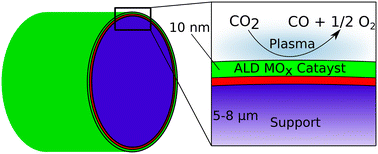Characterizing catalyst function and transformations in the plasma reduction of CO2 on atomic layer deposition-synthesized catalysts†
Abstract
The enhancement of CO2 reduction in atmospheric-pressure, non-thermal plasma has been shown using a variety of catalyst systems with ranging composition, particle sizes, and morphologies. Improvements in CO2 conversion can be attained by choice of catalyst material. However, inhomogeneity in the material distribution arising from the synthesis affects the catalytically active surface area and dielectric environment that modulates the plasma properties near the catalyst. Atomic layer deposition (ALD) can be used to control the composition of ultra-thin layers on support materials. We used ALD to synthesize metal oxide catalyst coatings on high surface area supports. We found that TiO2 achieved significantly higher yields of CO2 conversion (to CO and O2) at low reactor power compared to ZnO or Al2O3, materials commonly used as a support for other catalysts. We also observed an unexpected increase in the catalytic activity on ZnO with increasing power. The results here suggest that ALD can unambiguously isolate the catalytic effects of materials in plasma reactors.

- This article is part of the themed collection: Editor’s Choice – Ryan Richards


 Please wait while we load your content...
Please wait while we load your content...